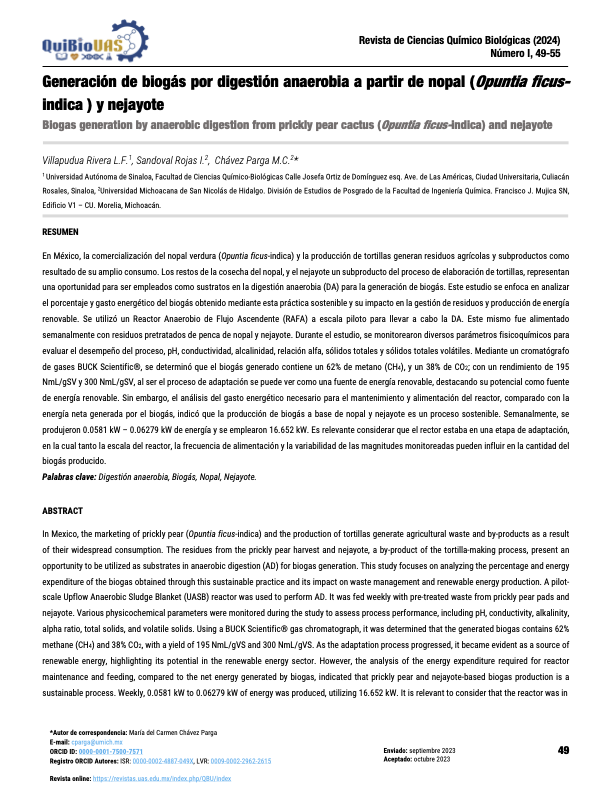Generación de biogás por digestión anaerobia a partir de nopal (Opuntia ficus-indica) y nejayote.
Palabras clave:
Digestión anaerobia, Biogás, Nopal, NejayoteResumen
En México, la comercialización del nopal verdura (Opuntia ficus-indica) y la producción de tortillas generan residuos agrícolas y subproductos como resultado de su amplio consumo. Los restos de la cosecha del nopal, y el nejayote un subproducto del proceso de elaboración de tortillas, representan una oportunidad para ser empleados como sustratos en la digestión anaerobia (DA) para la generación de biogás. Este estudio se enfoca en analizar el porcentaje y gasto energético del biogás obtenido mediante esta práctica sostenible y su impacto en la gestión de residuos y producción de energía renovable. Se utilizó un Reactor Anaerobio de Flujo Ascendente (RAFA) a escala piloto para llevar a cabo la DA. Este mismo fue alimentado semanalmente con residuos pretratados de penca de nopal y nejayote. Durante el estudio, se monitorearon diversos parámetros fisicoquímicos para evaluar el desempeño del proceso, pH, conductividad, alcalinidad, relación alfa, sólidos totales y sólidos totales volátiles. Mediante un cromatógrafo de gases BUCK Scientific®, se determinó que el biogás generado contiene un 62% de metano (CH4), y un 38% de CO2; con un rendimiento de 195 NmL/gSV y 300 NmL/gSV, al ser el proceso de adaptación se puede ver como una fuente de energía renovable, destacando su potencial como fuente de energía renovable. Sin embargo, el análisis del gasto energético necesario para el mantenimiento y alimentación del reactor, comparado con la energía neta generada por el biogás, indicó que la producción de biogás a base de nopal y nejayote es un proceso sostenible. Semanalmente, se produjeron 0.0581 kW – 0.06279 kW de energía y se emplearon 16.652 kW. Es relevante considerar que el rector estaba en una etapa de adaptación, en la cual tanto la escala del reactor, la frecuencia de alimentación y la variabilidad de las magnitudes monitoreadas pueden influir en la cantidad del biogás producido
Descargas

Descargas
Publicado
Número
Sección
Categorías
Licencia
Derechos de autor 2024 Revista de Ciencias Quimico Biologicas

Esta obra está bajo una licencia internacional Creative Commons Atribución-SinDerivadas 4.0.

